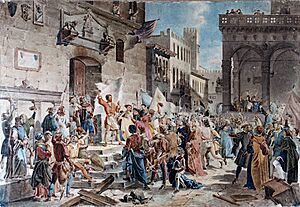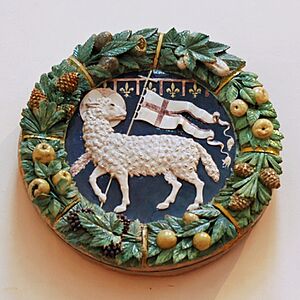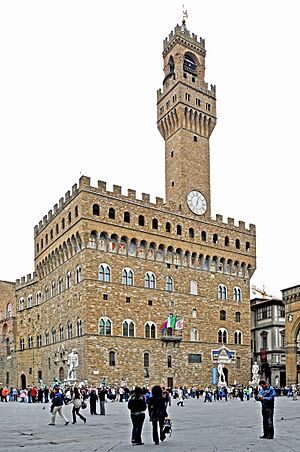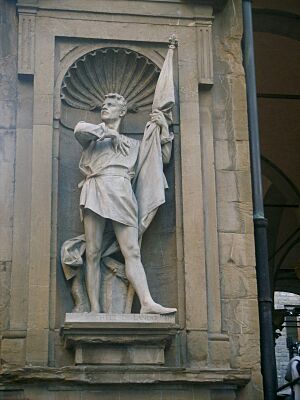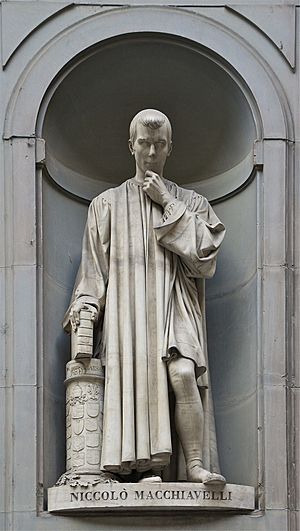Ciompi Revolt facts for kids
The Ciompi Revolt (pronounced CHOM-pee) was a big uprising by workers in the city of Florence, Italy. It happened between 1378 and 1382. These workers were mostly artisans and laborers who didn't belong to any official guilds. This meant they couldn't take part in the government of Florence.
These workers were very unhappy with the rich and powerful families who ruled the city. They also had to pay very high taxes, which many couldn't afford. This forced some people to leave their homes. The revolt led to a new government made up of wool workers and other regular people. This new government lasted for about three and a half years.
The Ciompi Revolt happened in three main parts. First, there were calls for changes in May and June. Then, a violent takeover happened in mid-July. Finally, the Ciompi government fell at the end of August 1378.
Some important people were involved. Salvestro de' Medici represented the middle and upper classes. A mysterious group called "The Eight (Saints)" represented the lower classes. Caught in the middle was Michele di Lando, a wool worker who became a leader.
Even though the revolt was short, it had a lasting effect on Florence. It changed society in the 1400s and became a famous event that historians still study today.
Contents
Why the Revolt Started: Florence's Problems
Before the revolt in 1378, Florence had many problems that led to the uprising.
Unstable Government and Rich Families
The government in Florence was not stable. The smaller guilds, called the Arti Minori, often argued with the seven major guilds, called the Arti Maggiori.
Between 1339 and 1349, many rich families lost their money, and trade slowed down. The economy wasn't doing well. Also, workers like artisans and laborers were not allowed to form their own groups.
Many rich rulers died from the Black Death or left the city. This led to "new men" (gente nuova) becoming powerful. These were immigrants who became rich through trade. The "new men" and the smaller guilds didn't like the old ruling families.
In 1375, the "new men" challenged the power of the old rulers. At the same time, Florence went to war against the Pope, which cost a lot of money. By June 1378, the old rulers and the "new men" had broken their truce, setting the stage for the revolt.
Rich vs. Poor: Who Were the Ciompi?
A big reason for the revolt was the tension between the rich and poor people in Florence. It was hard to tell exactly who was considered "upper class." Usually, if you had a famous family name, you were part of the rich families.
On the other side were the popolo minuto, meaning the working classes. This group included many poor laborers who came from villages to find work in the city. Many of these workers, called ciompi, were kept poor by forced loans, high taxes, and lots of debt.
The most important thing about the ciompi was that they had no say in the government. They weren't part of any guilds. The word ciompi comes from the Florentine word for 'carding wool' (ciompare). Wool workers were the largest group in the revolt, but other workers like tavern owners also joined.
Rising Taxes and Debt
In Florence in 1371, taxes were unfair. People in the mountains paid three times more taxes than those in the plains. These higher taxes weren't just because of wars. Florence needed more money to pay soldiers to fight against the Ubaldini family, who controlled peasants in the mountains.
After the Black Death, there was more crime and attacks on merchants. This also meant Florence needed more soldiers. To pay for these soldiers, Florence went deeper into debt. The rich rulers made people in the countryside pay even more taxes.
As taxes kept going up, many mountain people left their homes. This made the shortage of workers, already bad after the Black Death, even worse. There was a growing gap between the rich and the popolo minuto. Even before the Ciompi Revolt, there were smaller rebellions by workers, like one led by Aldobrando di Ciecharino in 1343.
The Ciompi Revolt: What Happened?
The Ciompi Revolt was a big uprising in Florence in 1378. It was led by wool carders, called Ciompi, and other workers who didn't belong to guilds. They wanted a voice in the government and changes to debt and tax rules.
This worker uprising started in June 1378 and ended in August of the same year. It was a fight for power between Florence's rulers, the official guilds, and the "Sotto posti" (un-guilded workers), which included the Ciompi.
Florence's wool industry was huge, selling fabrics all over Italy and overseas. It employed about a third of Florence's population. Many problems leading to the revolt were about how guilds and non-guild members related to each other, and how they related to the city's rulers, called the Signoria.
Guilds were very important in Florence's politics. They helped their members with work, taxes, and money. They also represented them in government and controlled who could join. There were seven major guilds (for rich merchants and bankers) and fourteen minor guilds (for artisans like shoemakers and tailors).
However, many workers were left out of the guild system. This meant they had less protection and couldn't be involved in city politics. For example, out of about 14,000 people in wool making, only about 200 could join a guild. The rest, the Sotto posti, couldn't join or even create their own guild. This unfair system allowed Florence's wool trade to grow but also created the conditions for the revolt.
The Ciompi were angry at the powerful Arte della Lana (the wool guild), which controlled Florence's economy. They also disliked their low wages and how they were treated because they weren't part of the guild system. The revolt in 1378 was a major moment for worker protests in Florence.
Three Stages of the Revolt
The Ciompi revolt happened in three stages:
- Stage 1: Calls for Change (May and June)
- Stage 2: The Uprising (mid-July)
- Stage 3: The Fall of the Ciompi Government (end of August)
In June 1378, the fourteen minor guilds started by asking for more power in the government. At first, the Ciompi were not violent. This early stage was more about power struggles between the guilds and between the Signoria and the working class.
The guilds asking for more power still didn't want the Sotto posti to form their own guilds. But the Sotto posti soon made their own demands. The Signoria, feeling threatened, made it harder to get into government and quadrupled the fee to join. This made the Sotto posti angry and turned them against the Signoria, joining forces with the Ciompi.
Calls for Change
On June 22, 1378, the first violence broke out. Un-guilded wool workers took up weapons and attacked government buildings and prisons.
However, it wasn't a full revolt yet. The Signoria tried to calm the workers with talks, but they offered very few real changes. The Ciompi were still without guilds or power. The Signoria's delays and small efforts likely led to the second, more violent stage of the revolt.
The Uprising
On July 21, the working classes took over the government by force. They made a wool carder named Michele di Lando the new leader, called the gonfaloniere of justice. They showed their blacksmith's flag at the Bargello palace.
Thousands of armed wool workers (the Ciompi) and Sotto posti surrounded the Signoria. They forced the government to create three new guilds, giving them access to political power. The Ciompi mostly wanted fair rights, similar to what other minor guilds had. They wanted reform, not a complete revolution.
The three new guilds had about 13,000 members. The 21 old guilds only had about 4,000 to 5,000 members combined. After these new guilds were formed, almost every man in Florence could take part in the city government.
The Ciompi's demands were quite modest, considering how they took power. They mainly wanted a guild for wool workers and to increase wool production to create more jobs. They didn't demand to own the factories. Their ideas were still based on the traditional guild system, aiming to protect their economic interests.
However, the new Ciompi government faced problems. They wanted to elect their own leaders, reduce harsh punishments, and change the tax system. But the new government was weak. Only half of its members were actually Ciompi; the rest were middle-class or from other jobs. This mix of interests and a feeling of betrayal when Michele di Lando seemed to turn against them led to the third stage of the revolt.
The Fall of the Ciompi Government
At the end of August 1378, arguments among the Ciompi themselves and harsh actions against their enemies caused Michele di Lando to arrest two Ciompi leaders. The next day, di Lando rode out of the palace and cleared the main square of a militia from the new guilds. They were shouting "Long live the popolo minuto" and demanding di Lando's government step down.
The workers' militia came back, and a battle broke out in the Piazza della Signoria. The Ciompi and Sotto posti fought against the forces of the major and minor guilds, led by the butchers' guild. Many Ciompi and Sotto posti were defeated that day. This day is known as one of the bloodiest in Florence's history.
On September 1, citizens agreed to dissolve the Ciompi guild. However, the government still carried out some Ciompi-led reforms, like creating a direct tax on household wealth in October 1378.
The Ciompi revolt involved many social, economic, and political factors. The guild system played a big part, and guild members were key in ending the Ciompi's short rule. Even though the Ciompi's demands were modest, the idea that they could live peacefully with all other groups was unrealistic. The disappointment after the government collapsed and the guilds were dissolved led to less worker unrest in Florence's cloth industry for years to come.
Important People in the Revolt
Salvestro de' Medici
Salvestro de' Medici was a rich and noble man, a less famous cousin of the powerful House of Medici banking family. Some people blamed him for starting the Ciompi rebellion. He made mistakes in his fight against another political group, which hurt his family's reputation and exposed others to the angry crowd.
"The Eight (Saints)"
Very little is known about "The Eight (Saints)" and who its members were. This group of radical Ciompi rebels was also called Gli Otto Santi del Popolo di Dio (The Eight Saints of the People of God). They might be confused with a more famous group, the "Eight of War," who opposed the Pope in 1375.
The "Eight of War" were powerful during the Ciompi Revolt but played a small role in it. The "Eight Saints" of the Popolo Minuto created a kind of shadow government to Michele di Lando's rule. They even got the right to stop government laws. But di Lando's government defeated these challengers on August 31, 1378.
Michele di Lando
Not much is known about Michele di Lando before the Ciompi Revolt, as people from the lower working class didn't usually leave many records. We know he was a woolcomber, his mother was a washerwoman, and his wife ran a butcher shop. He was a foreman for many workers and earned enough to pay small taxes. He also had some military training.
His rise to power was like a rags-to-riches story. He walked into the palace barefoot and took control because the people asked him to. This amazed even some of the powerful rulers. One person said, "...This Michele di Lando, wool comber, was lord of Florence for twenty-eight hours and more. Oh dear Lord, what great miracles you show us!..."
When Michele di Lando took power, he wanted to show he could govern on his own. He chose new leaders himself. Once he had power, his government worked with the general people of Florence. This angered the radical members of the Popolo Minuto, who then formed their "Eight Saints" to oppose him. After a final clash with these radicals, the old rulers returned to office when Michele di Lando's term ended. However, this new government didn't last long. It was overthrown in 1382, and di Lando was sent away from Florence for working with the old rulers.
The Revolt's End and Its Lasting Effects
The End of Ciompi Rule
The Ciompi governed Florence until 1382. At that time, fears of foreign attacks and arguments between wool merchants and dyers were used by the rich families to justify stepping in and taking control of the government again.
After 1382, the new government worked hard to remove the power of the guilds created by the Ciompi. They tried to make the un-guilded workers seem like criminals.
The Ciompi Rebellion was not very long, lasting only three and a half years (1378–1382). But it showed the long-standing social problems in Florence in the late 1300s. It also had a lasting impact on many future generations. It greatly influenced Florentine society in the 1400s and became a memorable moment that historians still study and interpret differently.
Impacts on Florence in the 1400s
After the Ciompi Uprising, the restored government in Florence did try to help the Ciompi artisans, for example, by making some tax reforms. However, the rebellion left a lasting fear and hatred of the Ciompi in the minds of Florence's rich families (both old and new nobility).
This fear created even more tension between the new rich families and the working class than before the uprising. The rich constantly worried about secret plots by the common people. This led them to want a stronger, more centralized government that could easily crush any future revolts. This eventually helped the Medici family, the most powerful banking family in Florence, rise to power. They became the unofficial rulers of Florence in the 1400s, completely changing how the city was governed.


